
- Homepage
- Binding
- Cloth (46)
- Cloth & Boards (2)
- Disbound (3)
- Fine Binding (180)
- Framed (2)
- Good (8)
- Hardback (105)
- Hardcover (876)
- Hardcover / (3)
- Hardcover W / Jacket (3)
- Leather (458)
- Leather / Hardcover (4)
- Manuscript (26)
- Manuscript, Unbound (2)
- Original Copy (94)
- Paperback (6)
- Pigskin (2)
- Softcover, Wraps (76)
- Vellum (51)
- Very Good (2)
- ... (2800)
- Illustrator
- Alice B. Woodward (2)
- Andy Warhol (2)
- Arthur Rackham (3)
- Beatrix Potter (3)
- Black Magic (26)
- Edmund Dulac (3)
- Francis Hart (3)
- Gustave Doré (22)
- Hy. Sandham R.c.a. (3)
- Illustrated (2)
- John R. Neill (3)
- John Tenniel (10)
- M. L. Kirk (3)
- Mabel Lucie Attwell (5)
- Multiple (2)
- Not Stated (8)
- Oliver Herford (5)
- Unknow (3)
- Unknown (20)
- Various (12)
- ... (4609)
- Language
- Subject
- Americana (54)
- Art & Photography (51)
- Children's (145)
- Classic Literature (10)
- Cooking (43)
- Exploration & Travel (43)
- History (227)
- Home & Garden (8)
- Illustrated (28)
- Law & Government (17)
- Literature (8)
- Literature & Fiction (239)
- Military & War (16)
- Performing Arts (10)
- Philosophy (14)
- Poetry (8)
- Reference (45)
- Religion, Bibles (15)
- Science & Medicine (97)
- Sports & Recreation (12)
- ... (3659)
- Topic
- Action, Adventure (12)
- American (us) (32)
- Ancient (13)
- Architecture (13)
- Bible (53)
- Bibles (12)
- Christianity, Bibles (163)
- Classics (122)
- Europe (15)
- European (16)
- Historical (96)
- Judaism (12)
- Literature (58)
- Magic (17)
- Medicine (30)
- Occult (172)
- Poetry (50)
- Religion (48)
- Sets (38)
- Victorian (19)
- ... (3758)
- Year Printed
Antique Religious Book. The very rare. End of the 16th century
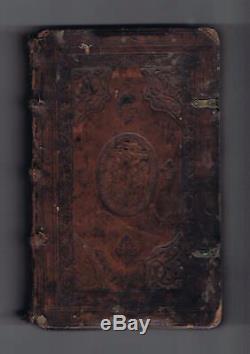
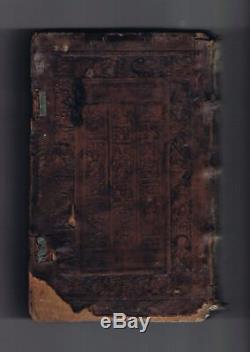
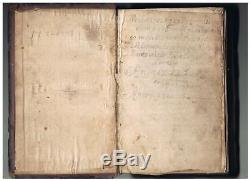
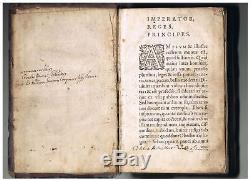
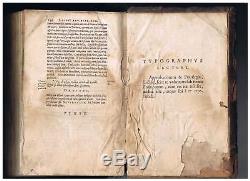
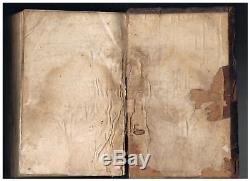
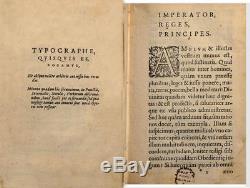
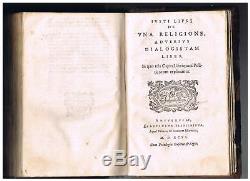
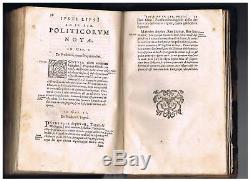
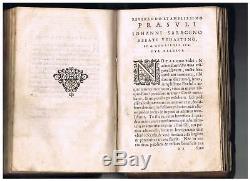
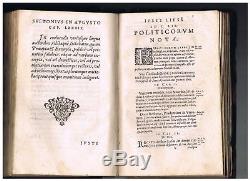
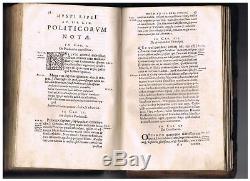


Politicorum siue Ciuilis doctrinae libri sex. Qui ad principatum maximè spectant. Additae Notae auctiores, tum &De vna religione liber.
Antverpiae, ex officina Plantiniana, apud uiduam & Ioannem Moretum. The book was kept in the territory of the eastern Latvia.
A cover of the late XVI century, 21113838 mm planks in brown leather with embossing and remains of gilding of five embossing fragments, with fragmentary losses of leather and two clasps. The centre of the upper plank has. An embossed image of Christ on the Golgotha cross and two figures standing in front.
The composition is made into an oval frame with text on it: CHRISTUS FACTUS EST PRONOBIS OBEDIENS USQUE AD MORTEM AUTEM CRUCIS. On the back side of the cover, there are images of eight antique persons with names (read as OVIDIUS, VIRGIL and CICER) and twelve Christian saints. The binding is original, the 1. Sheet of flyleaf with possessory notes. 196125mm has 227 sheets: 8 sheets of the first notebook the 1. Lost sheet has been restored by a sheet of printer print + 4 sheets of the second notebook + 142 sheets of the first note + 5 sheets + 68 sheets of the second note. The block is stitched of notebooks, which has 4 to 8 stitched sheets.The paper of XVI century, Alexandrian (sheets, before cutting into 4 parts, were not less than 4152 cm), verge paper. 24-26 mm, 11 verges per 1 cm. Fragments of watermark Glove (type - Likhachov 3259) are located at the upper edge of sheets, but not on the fold (watermarks were not in the centre of one of the sheet halves, but closer to the side edge of the sheet).
On the first sheet and on page 81 of the second note, there is a printers Plantin mark a hand holding a compass and a twisting ribbon with a motto LABORE ET CONSTANTIA (constant hard work). For design, dropped capitals in ornamented squares and colophons were used. Contents: De consilio et forma nostri operis (Advice and form of our activities, page 5-7); Monita quadam, siue Cautiones (Some warnings or cautions, page 7-9); Ordo et Index librorvm singillatim et capitvm (Order and contents of the book separately and jointly, page 10-12).
Politicorum siue Ciuilis doctrinae libri sex (page 1-283 of the first note); Privilegii (sheets between the pages of the first and the second note); Politicorum notae (page 1-79 of the second note); De una religione, adversus dialogistam liber (page 81-134 of the second note). On the sheet of flyleaf, there is a note made by a pencil: Naiswiensza pano gormuimo (unreadable) pisalsina go menkie proba piora dob.. Czarnega (unreadable) Barzo wielie B. Anno 1772 1773 Antoni Piekarski. On the reverse of the flyleaf, there is a note made by Indian ink, where the name Henrici Schrüders can be read.
At the foot of the second sheet, there is a note made by Indian ink: Exlibris Bibliotheco Paroch_ Li. South Netherlandish humanist and expert of the classic Latin language, known by his theories relating to politics and morality. He became popular in Europe by authoritative editions of Latin prose, especially Tacitus (1574) and Seneca (1605). In 1589, he published a political treatise, in which he defended the necessity of rationalization of the state machine. The name of Just Lipsium was given to a building (en: Justus Lipsius building), in which the Council of the European Union is located.
Firm Officina Plantiniana, also known as Plantins printing office or Plantijnse Drukkerij, was founded in 1555 in Antwerp by the greatest printer and publisher of that time Christophorus Plantinus (15201589). With the lapse of time, Officina became the largest printing office and publishing house in Europe and facilitated transformation of Antwerp, together with Venice and Paris, into one of the leading western centers of printing. Plantins son-in-law Jan Moretus managed the printing office after his death, as he inherited it.
Offsprings of Moretus family continued the business till 1876. The item "Antique Religious Book. End of the 16th century" is in sale since Monday, August 13, 2018. This item is in the category "Books\Antiquarian & Collectible".
The seller is "abaro-serge" and is located in Daugavpils. This item can be shipped worldwide.- Modified Item: No

